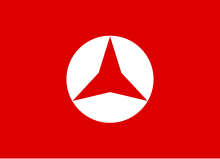Frente Popular
The Frente Popular ( Spanish for " Popular Front ") was an electoral alliance supported by left and liberal politicians, which was formed in the final phase of the Second Spanish Republic on the occasion of the new elections at the beginning of 1936. The popular front alliance founded the previous year in France , which had formed against right-wing parties there, served as a model .
After President Niceto Alcalá Zamora had dissolved Spain's parliament, the Cortes , and scheduled new elections for February 16, 1936, the Frente Popular was formed on January 15 .
It essentially comprised the moderate republicans of the Izquierda Republicana and the Unión Republicana , the socialists of the PSOE and the UGT , the communists of the PCE and the left communists of the POUM . She was also supported by the Catalan ERC and the anarchists from CNT / FAI ; the latter renounced for the first time to call for an election boycott .
The members of the Popular Front understood their alliance as a defense of the “national interests of the republic” against the “ reaction ” in the country and agreed on a series of measures that should strengthen the foundations of the republic. The remaining political declarations of intent were rather moderate and essentially shaped by statements from the republican parties, which rejected the nationalization of property and the introduction of unemployment insurance, for example.
In the elections, the Frente Popular won by a narrow margin over the Frente Nacional ("National Front") of the right, which amounted to around 150,000 votes. The political center was meaningless with only 500,000 votes. Since majority voting was in force in Spain at that time , the election winner was able to achieve a majority of 263 of the 473 seats in parliament. Although mutual accusations of local irregularities were raised, which was no exception in the unstable democratic system of the time, there is overall - also from the point of view of today's research - that the Popular Front emerged as a narrow but clear winner of the elections. The new parliamentary majority then set up a committee to review the election results. However, this only checked irregularities in constituencies where candidates from the Frente Nacional or the Center had won. This and the fact that an official election result was never published, however, gave the opponents of the Frente Popular room to question the election results.
The new government - initially under Manuel Azaña , then under Santiago Casares Quiroga after his election as president in May - was formed exclusively from the ranks of the two republican parties, but could rely on the tolerance of the other Popular Front parties. But this also resulted in the weakness of the governing parties, which could not restore order against the will of their allies, which would have required intervention against the militant sections of the supporters of these allies.
Meanwhile, the decade-long social and political confrontation intensified across the country against the backdrop of an economic crisis, which ultimately led to a military coup in July of that year and then to the Spanish Civil War .
literature
- Nieves González, Torreblanca (Madrid-Patio de Butacas) . Edition La Librería, Madrid 2007. pp. 76 to 78.
See also
Individual evidence
- ^ Pacto - Programa del Frente Popular . Text of the January 1936 agreement
- ↑ Cf. on this: Nieves Gonzales, Torreblanca (Madrid-Oatio de Butacas). Pp. 76 to 78.
